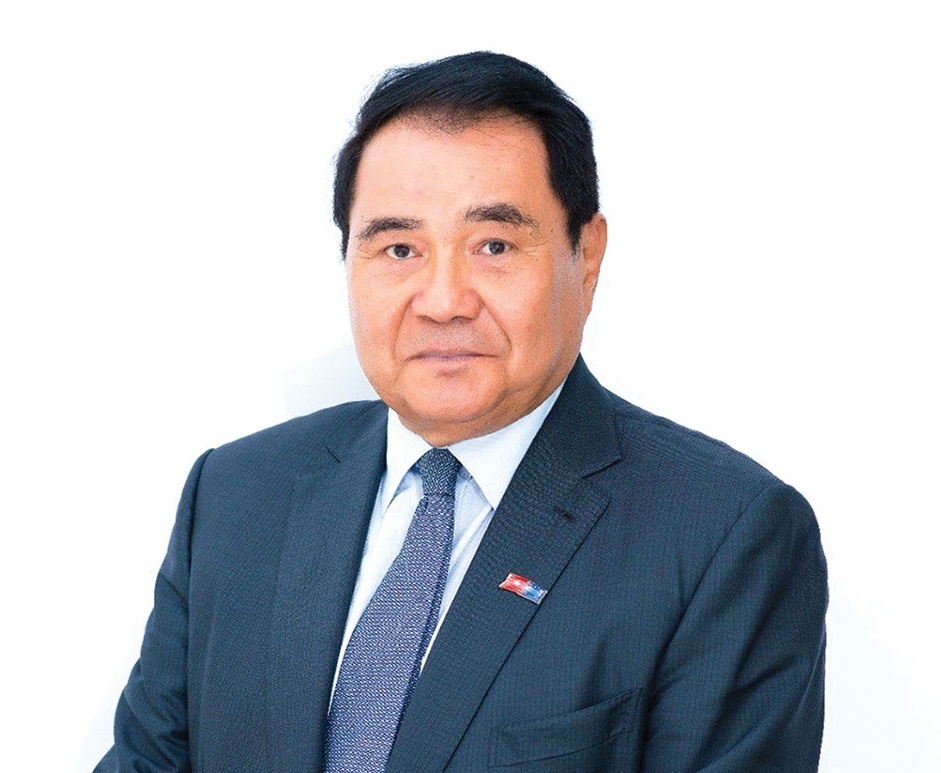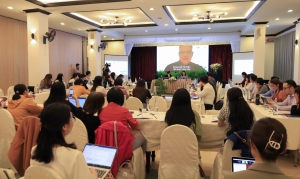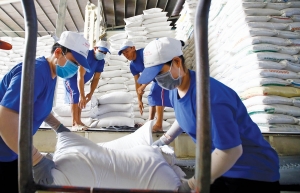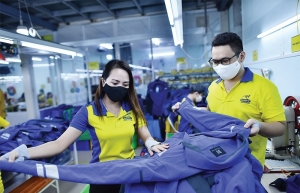Smooth progress bodes well for EVFTA
It has been three years since the European Union-Vietnam Free Trade Agreement (EVFTA) came into effect. Could you share some insights into the impact of the agreement on bilateral trade and investment?
 |
| Jean-Jacques Bouflet, vice chairman of advocacy at the European Chamber of Commerce in Vietnam (EuroCham) |
Since the EVFTA’s entry into force, there has been sizeable growth in bilateral exports, with total turnover of trade under the EVFTA reaching almost $130 billion by mid-2023, and trade turnover amounting to $66.8 billion in 2022.
Vietnamese exports to the EU increased by 24 per cent compared to the previous period before the agreement, but EU exports to Vietnam faced some difficulties. While import duties were reduced, special consumption tax increases particularly affected goods where import duty reduction was expected.
But in general, the implementation of the EVFTA has progressed relatively smoothly, with both the European Commission and Vietnamese customs effectively executing duty reduction measures. While minor challenges related to customs valuation and intra-community sales have arisen, collaborative efforts are underway to address technical issues.
Could you elaborate on the sectors that have particularly benefited from the EVFTA since 2020?
The traditional export sector has witnessed growth in terms of quantity, even though there haven’t been significant changes in the quality of exports.
It’s crucial to remember that the gradual reduction of duties under the EVFTA spans over 10 years for Vietnam and seven years for EU imports. The full impact of the deal is expected to be realised after a decade or more, explaining why substantial shifts in sectoral structures have yet to occur.
Specific growth has been noted in sectors like aquatics, vegetables, coffee, seafood, rice, electronics, computers, footwear, textiles, and machinery. Services have expanded as well, but the main effect will come later on. Issues with technical barriers to trade, custom valuation, and intra-community sales were reported, with many being resolved.
How have Vietnam’s small- and medium-sized enterprises (SMEs) fared under the EVFTA?
SMEs in Vietnam have shown good understanding of the EVFTA, adapting to new rules of origin that require self-certification of origin for goods. While duty reduction is a key aspect of the agreement, it’s not the sole determinant of SMEs’ success in the European market.
Brand recognition and establishing connections with partners in the importing country play crucial roles. Being a part of a larger business network is advantageous for SMEs seeking to maximise the benefits of the EVFTA.
How does the EU-Vietnam Investment Protection Agreement (EVIPA) connect to the existing trade framework between both sides?
The EVIPA is a complement to the EVFTA designed to protect investments between the EU and Vietnam. Functioning as a safeguard for investments, the EVIPA instils confidence in European firms to invest in Vietnam by ensuring equitable treatment and protection from bias, thereby creating an equitable playing field for European investors.
Its key provisions encompass commitments for market access, adherence to national treatment principles, rigorous investment protection standards, and effective dispute resolution mechanisms, all while enhancing administrative procedure transparency that influences investments.
Although the EVIPA logically should precede trade development, its ratification has been delayed due to competence sharing issues between the EU and its member states. This delay has impeded the psychological boost that would encourage further investment, but existing national agreements remain in effect.
What are the challenges in the ratification process of the EVIPA, and what are the implications of Italy’s recent ratification?
Unlike trade, which only requires ratification by the EU, the EVIPA requires double ratification from both the EU and all 27 individual member states. This complex process has slowed down full implementation.
Italy’s recent ratification is a major step forward, as Italy is the third-largest economy in the EU. However, it does not yet legally allow Italy to benefit from EVIPA provisions. Italian investors will likely wait for full ratification by all states before significantly increasing investments based on EVIPA protections.
Meanwhile, about half of the EU member states still need to ratify the treaty for it to enter into force. Although this delay prevents the immediate legal effect and psychological boost of the EVIPA, there’s continuity with the existing national agreements that continue to provide investment protection in the interim.
What sectors or industries do you anticipate will experience growth as the EVFTA continues to unfold?
While duty reduction is a driving force, other factors such as the complementary nature of the two economies play a significant role in trade dynamics. Vietnam’s exports to the EU have seen growth, particularly in sectors where the EU is not a major producer. Sectors such as electronic devices, footwear, textiles, machinery, and services hold promise for future expansion.
The EVFTA is a long-term commitment, and its full effects are yet to be realised, especially as duty reductions and market access unfold over the coming years.
What specific challenges do foreign investors face in Vietnam’s regulatory landscape, and how can Vietnam uphold its allure amid prevailing global challenges?
Foreign investors in Vietnam have encountered challenges related to bureaucracy, administrative hurdles, and inconsistent interpretations of regulations. For instance, issues with acquiring necessary permits have hindered investment processes. These challenges can lead to delays and discourage potential investors.
To maintain its allure, Vietnam should foster a business-friendly atmosphere with minimal unnecessary obstacles. By safeguarding the allure of its labour force and continually refining business conditions, Vietnam can distinguish itself as a dependable investment hub, even in the face of adversity.
Large-scale investments often involve navigating intricate bureaucratic processes. While solutions are eventually found, these challenges can be time-consuming and hinder the investment’s momentum. For SMEs, especially in the technological sector, similar obstacles can prove critical.
Therefore, we suggest Vietnam could contemplate establishing a central authority or entity dedicated to streamlining investment approvals and permit processes. This approach would ensure transparency and efficiency, benefitting both significant investments and SMEs, particularly those in the technology sector. These enhancements would further incentivise foreign investors to select Vietnam as their preferred investment destination.
What are EuroCham’s future priorities and strategies in Vietnam, along with its efforts to improve the investment landscape?
EuroCham has a comprehensive set of priorities and strategies aimed at shaping an improved investment landscape in Vietnam. Foremost, it is committed to ensuring the effective implementation of the EVFTA. This entails advocating for equitable trade practices and maximising the mutual benefits for both the EU and Vietnam.
Moreover, EuroCham plays a pivotal role in bridging the gap between Vietnamese exporters and European importers. By facilitating these connections, the chamber actively bolsters trade opportunities and fosters stronger economic ties between the two regions.
Recognising the significance of addressing challenges within the investment process, particularly within the manufacturing sectors, EuroCham advocates for reforms that promote transparency, efficiency, and consistency in investment procedures. This involves close collaboration with local authorities and the sharing of valuable insights into the obstacles encountered by investors.
By working constructively with governmental bodies, EuroCham aims to cultivate a more favourable investment environment in Vietnam. This environment not only attracts foreign investment but also supports sustainable economic growth and advancement for businesses from both Europe and Vietnam.
 | Vietnamese businesses trained in EVFTA’s Rules of Origin Vietnamese businesses had the opportunity to improve their knowledge on Rules of Origin (ROO) and receive useful information from experts to take full advantage of the recent European Union–Vietnam Free Trade Agreement (EVFTA) at a workshop organised by the ARISE+ Vietnam Project. |
 | Taking advantage of EVFTA for imports Thanks to the EVFTA, Vietnamese enterprises have opportunities to increase exports to the EU market and promote imported goods and raw materials from the EU with lower prices. |
 | Maximising the benefits of EVFTA Entered into force in the context of the bilateral development of relations, the EU–Vietnam Free Trade Agreement has brought both positive impacts in many fields. Peter Bernhardt, Dr. Eduardo Austin and Prof. Dr. Konstantinos Athanasiadis of the ARISE+ Vietnam Project explain how Vietnam can face up to the challenges that the country’s private and public sector need to address in the years to come. |
What the stars mean:
★ Poor ★ ★ Promising ★★★ Good ★★★★ Very good ★★★★★ Exceptional
Related Contents
Latest News
More News
- HEINEKEN Vietnam partners with Ho Chi Minh City Traffic Police on road safety drive (December 17, 2025 | 09:42)
- BUV and China’s CSCSE sign MoU to boost educational cooperation (December 17, 2025 | 08:00)
- PVT Logistics honoured with ‘Fast Enterprise Award’ at APEA 2025 (December 16, 2025 | 18:22)
- Empowering Sustainable Data Centers with Smart Infrastructure Solutions (December 16, 2025 | 13:59)
- Vietjet wins gold ESG transport sustainability award in Taiwan (China) (December 13, 2025 | 22:03)
- Legal framework completed for national digital transformation (December 13, 2025 | 21:55)
- SOAR initiative launched at TECHFEST Vietnam 2025 (December 13, 2025 | 10:00)
- Mondelez Kinh Do secures fourth Top 100 Sustainable Company nod (December 13, 2025 | 09:00)
- Vietnam advances three-pillar strategy to prevent cervical cancer (December 12, 2025 | 20:00)
- MCH shares secure approval for listing on HSX (December 12, 2025 | 12:59)

 Tag:
Tag:



















 Mobile Version
Mobile Version